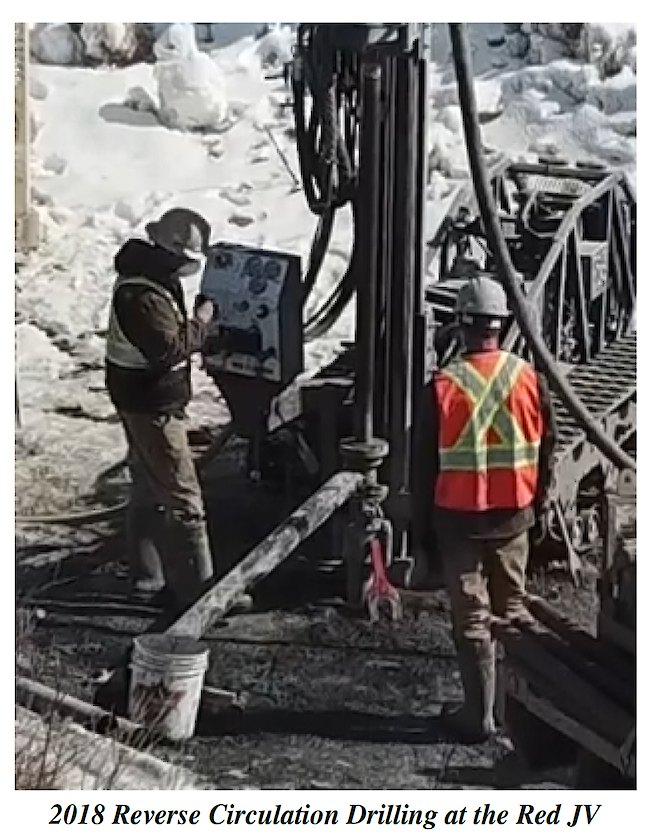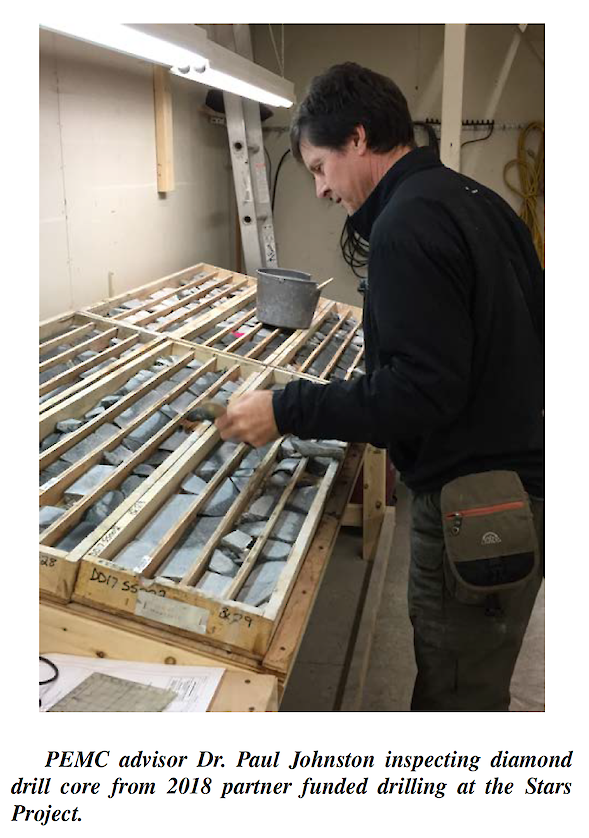President’s Newsletter

On March 22, 2018, Pacific Empire Minerals Corp. ("PEMC" or the "Company") began trading on the TSX Venture Exchange under the symbol PEMC. Immediately upon listing of its shares the Company took delivery of its custom built reverse circulation ("RC") drill that was manufactured for the Company, and since delivery it has been mobilized to the Company’s Red JV property with EnGold (TSXV:EGM). Drilling has now commenced and management anticipates 2018 will be a very active and exciting year.
2018 Exploration Outlook
Over the past five years PEMC has been developing a portfolio of copper-gold projects in British Columbia, two of which are currently under option and being advanced through partner funded exploration. PEMC intends to use its own RC drill to advance six of the remaining projects during 2018, in addition to continuously replenishing the portfolio with attractive projects and targets for further exploration. Adding additional partner funded exploration programs will be pursued by the Company following the completion of RC drilling at the Wildcat, Red, Nub East, Hogem, Copper King and Kitimat properties in 2018. The objective is to identify those projects with the greatest potential for continued exploration and partner-funded diamond drilling, while maximizing the Company’s retained interest in projects and associated cash and share payments. Mineral exploration is a high-risk endeavor with the potential for spectacular rewards if the ultimate goal of a new mineral discovery is achieved. Although money, technology, science, and persistence are important attributes in mineral exploration and enhance the chances of success, the inherent odds of making a discovery on any single target remain low. As a result, a large number of exploration targets must be tested in order to maximize the potential for success. If money was of no concern, the approach to mineral exploration might be relatively straightforward: brute force diamond drilling. Of course, this is not the case and the mining industry is increasingly in competition with other sectors for investment capital to fund exploration programs. Of all the exploration strategies and techniques, nothing can substitute for the drill hole.
Drilling represents a direct method of testing a target versus indirect methods such as geophysics and geochemistry. Despite all of the technological and scientific advances made over the last several decades the primary difference between successful and unsuccessful exploration companies is a dramatic difference in the amount of drilling they do. Drilling is really the only way to find out what is down there. PEMC believes that reverse circulation drilling offers a solution to the problem of maximizing the amount of drilling while minimizing exploration expenditures and shareholder dilution. For companies that employ the prospect generator business model and have multiple projects, prospecting with a diamond drill will almost certainly lead to a rapidly depleted treasury and the need to raise additional capital through increasingly dilutive financings. By purchasing our own reverse circulation drill with a motivated and dedicated field crew, we believe we will be able to minimize the cost of drilling while maximizing the number of metres drilled. In the end, exploration is not a science, it is a business. Science often seeks to understand, whereas exploration seeks discovery, by whatever means, with or without understanding. Our strategy is to test targets with a drill as soon as possible. If a test is negative then we must move on to the next target unless new ideas or data from the drilling justify further work. Once the snow levels in central British Columbia have receded sufficiently, PEMC will mobilize to the Wildcat Property located approximately 10 kilometres to the southwest of Centerra Gold Inc.’s currently producing Mount Milligan Gold Mine.
The Wildcat property is the Company’s Initial Listing Property and, as such, a significant exploration program is planned consisting of RC drilling with the potential for a limited, follow-up diamond drilling program. Induced polarization ("IP") surveys completed on the property in the spring of 2017 have outlined a roughly 3.5 x 1.5 kilometre area of high chargeability that has seen limited exploration to date. The resistivity signatures on the completed IP lines suggest that the chargeability anomaly is not likely related to a geologic formation.
The Red JV Property is the first project to be tested with PEMC’s RC drill. The location of the project, approximately 40 minutes from existing infrastructure in Williams Lake, southern British Columbia, is ideal for winter drilling and the initiation of 2018 RC drilling on the Company’s projects. The exploration target consists of a 2.4 x 1.4 kilometre wide area of anomalous IP chargeability coincident with anomalous copper-in-soil geochemistry and a favourable magnetic signature, located approximately 1.6 kilometres to the southwest of EnGold Mines Ltd.’s ("EnGold") G1 Discovery zone. The surrounding area is host to numerous skarn and copper-gold porphyry prospects including EnGold’s Spout Magnetite-Copper Deposit 1.9 kilometres to the north and Engold’s Aurizon South Copper-Gold Deposit 6 kilometres to the east. The Red JV property lies entirely within the outer boundaries of EnGold’s Lac La Hache property, located approximately 56 kilometres east-southeast of Williams Lake and 16 kilometres northeast of the village of Lac La Hache. The project area is serviced by BC Rail, BC Hydro and Westcoast Transmission natural gas.
Following completion of RC drilling at the Red JV property, PEMC intends to mobilize to the Kitimat Property located 20 kilometres from the town of Kitimat in west-central British Columbia. Although historical drilling has returned intervals up to 105 m @ 1.15 g/t Au and 0.6% Cu (DDH J-2010- 07) at the Jeanette target area, PEMC believes the best potential lies adjacent to this zone. Two targets, one immediately to the north and the other immediately to the south, have been prioritized for PEMC RC drill testing in 2018. During 2017, PEMC completed an airborne magnetic survey over the Nub East Property, located at a relatively low elevation, in the southern Toodoggone District. In order to target porphyry style systems PEMC management believes the 1,100 m - 1,200 m elevation level in the Toodoggone District is the ideal location to explore for porphyry copper deposits. This is because in the Toodoggone District, epithermal style precious metal deposits and prospects are typically located at elevations around 1,800 m. In a geological context this is important because porphyry style deposits are typically located below the higher level, epithermal environment. The 2017 airborne magnetic survey identified a magnetic high anomaly in a valley bottom at the target elevation. A PEMC RC drill program is planned for 2018 to test this target.
The Hogem JV Property is a joint venture with Divitiae Resources Ltd. where the two companies have identified a drill target based on soil geochemistry and ground geophysics. A PEMC RC drill program is planned for 2018 to test this target. PEMC has completed a number of exploration programs on the Copper King Property since its acquisition in 2014, including prospecting and geochemical studies, induced polarization geophysics, and more recently, an airborne magnetic survey. This work has identified a priority drill target in a valley bottom in the northern portion of the property. The only drill hole in this area was from a 1974 exploration program that intersected native copper in the bottom portion of the hole. A PEMC RC drill program is planned to test this target during 2018.
Over the last 12 months PEMC has strengthened its Board of Directors with the addition of Mr. Larry Donaldson and Mr. Keith Henderson. Both Larry and Keith are independent to the Company and bring a wealth of valuable experience to PEMC. Mr. Donaldson serves as Chair of the Audit Committee and is a Chartered Professional Accountant with extensive experience in public company audits and in accounting and tax planning for mineral exploration companies. Mr. Henderson is a mining industry executive with over 25 years’ experience throughout Africa, Europe and North and South America. Our Advisory Board was strengthened in 2017 with the addition of Dr. Neil Adshead. Neil joins Dr. Paul Johnston on the Advisory Board and together allows PEMC to draw on a wealth of knowledge and experience.
Partner Funded Exploration
In November of 2017, PEMC optioned its interest in the Stars Project, located approximately 60 kilometres to the northwest of Imperial Metals Huckleberry Mine, to ML Gold Corp. A diamond drilling program was initiated in January 2018, which was followed up with an airborne magnetic survey. Initial diamond drilling results, highlighted by drill hole DD18SS004, were successful in intersecting intervals of copper mineralization with up to 204 metres grading 0.45% Cu. In August of 2016, PEMC optioned the Pinnacle Reef Project to ML Gold and during 2016 and 2017, two diamond drill programs and one induced polarization survey were completed. The 2016 drill program consisted of three holes totaling 1,107 metres and focused on the Elbow target area, where previous partner OZ Minerals drilled during 2015. Results included anomalous intervals of gold with localized phyllic alteration. Following the completion of an induced polarization survey, ML Gold followed up in 2017 with an additional five diamond drill holes, totaling 1,080 metres, 4 kilometres to the north of the Elbow target area at the Aplite Creek Zone. Historical exploration by BP Minerals in 1994 at Aplite Creek was successful in identifying gold and copper in diamond drilling.

Exploration 101 - Induced Polarization
Induced polarization surveys are a valuable tool for base metals exploration. Shareholders have often seen IP surveys mentioned in our communications and we understand that, for some, these surveys may seem confusing, however, we believe it is an important exploration technique for shareholders to understand. In summary, IP surveys can provide an indication of an area’s mineralization potential before the first drill holes break ground. It is possible to use well-planned IP surveys to effectively narrow down drill targets in an area. An IP survey works by sending an electrical current through the ground and as a result the surfaces of metallic minerals become charged. An overvoltage is applied to the ground, and then switched off. Once the current is switched off, the overvoltage decays, but the ground is left with a small storage of energy. It is the amount of stored energy that gives clues into what minerals may be lying below the surface. Most rocks have a certain IP effect and many produce only a slight effect know as background noise, but most metal sulphides and some clay minerals give a significant IP signature. Areas that show an IP signature that suggests there are minerals of interest below can be good drilling targets. IP is arguably the most effective geophysical technique when exploring for disseminated sulphide deposits, such as copper porphyry deposits, as they are non-conducting and therefore not detectable by electromagnetic exploration methods. Example of results from an induced polarization survey at the Pinnacle Reef Project from 2017.
TSX-V:PEMC
m pemcorp.ca
T (604) 356-6246
B info@pemcorp.ca
